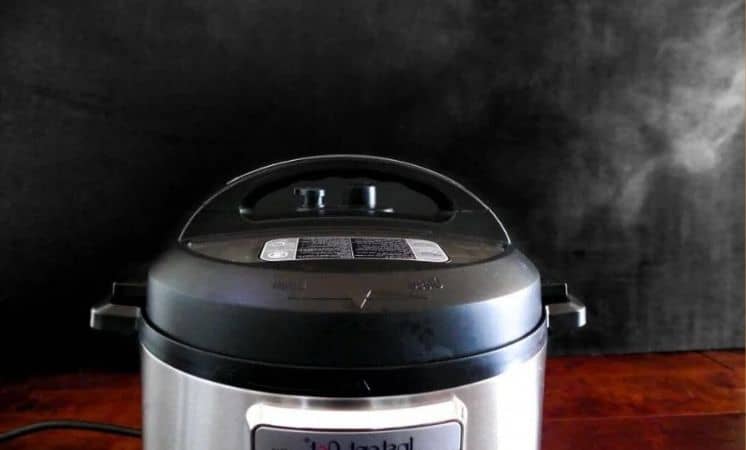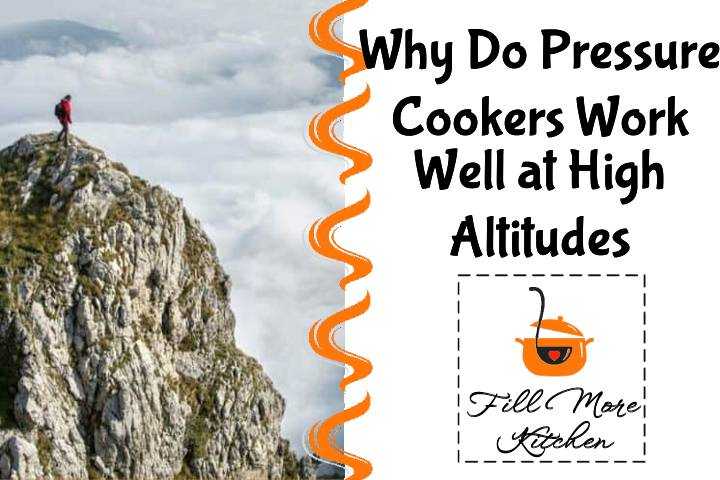At high altitudes, typically between 2,000 and 3,000 feet above sea level, cooking requires significant changes in time, temperature, and recipe due to the lower boiling temperature of water, drier atmosphere, and reduced oxygen and atmospheric pressure that make cooking take longer.
What makes pressure cookers effective at high altitudes is their ability to save time by avoiding the need for extended cooking periods and preserving moisture that would otherwise evaporate in such conditions.
However, pressure cookers offer more benefits than just cooking food quickly and efficiently. They can also effectively counteract the effects of atmospheric pressure, making them a useful tool for those living or traveling to high altitudes or hilly areas for outdoor activities such as hiking or camping.
Why Are Pressure Cookers Recommended for Cooking at High Altitudes?
Regardless of altitude, the boiling point of water is always lower than it is at sea level, with a difference of approximately four degrees Fahrenheit, as the boiling point is 208 degrees Fahrenheit instead of 212 degrees Fahrenheit at sea level.
At high altitudes, cooking methods that involve heat transfer through water or liquid will take longer to complete.
Although four degrees may not seem like a significant difference, it can greatly affect the cooking time required in pressure cookers at high altitudes due to the way chemical reactions function, as it takes much longer for the water to reach its boiling point.
What Causes the Delay in Water Reaching Boiling Point?
To reach boiling point, the vapor pressure of a substance should match the ambient pressure of the liquid. The ambient pressure is equivalent to the atmospheric pressure levels, which are lower at high altitudes, causing a delay in boiling.
Pressure cookers are effective in dealing with the challenges posed by lower atmospheric pressure and dry, thin air at high altitudes.
Pressure cookers can cook food in a much shorter time, typically an hour or two, compared to the usual eight to twelve hours. This is possible because the pressure cooker creates a sealed and highly pressurized environment that is moist, which cannot be achieved in high altitude areas.
As a result, pressure cookers guarantee that your food is not undercooked, retains its moisture by being sealed off from the dry air, and overcomes the effects of low atmospheric pressure at high altitudes by enabling liquids to boil above their normal boiling point.
Pressure cookers are essential for cooking at high altitudes because without them, you would need to increase your cooking time due to the lower boiling point of water, and simply increasing the heat will not speed up the cooking process but instead cause the water to evaporate more quickly.
Without needing to increase the cooking time required, a pressure cooker is the sole device that prevents this from happening.
How Is Cooking Affected When Using a Pressure Cooker at High Altitudes?

If your pressure cooker is equipped with only one pre-set weighted gauge, it will be necessary to extend the cooking time to compensate for the reduced cooking temperature, as mentioned in the following section.
When using a pressure cooker with multiple weights, it may be possible to compensate for high altitude cooking by utilizing a heavier weight; nevertheless, it is strongly advised to modify the cooking time instead as this guarantees safe and effective food preparation.
To ensure that there is no loss of water due to evaporation, it is recommended to lower the heat once the desired pressure has been achieved in the pressure cooker.
It is important to ensure that the pressure remains constant and matches the recommended gauge pressure, which can be found in the manufacturer’s manual.
How Do I Adjust Pressure Cooker Recipes for High Altitude Cooking?
When using a pressure cooker at high altitudes, it is crucial to remember to adjust the cooking time based on the elevation, with a general guideline of increasing the cooking time by five percent for every 1,000 feet above sea level after reaching 2,000 feet.
When cooking at high altitudes, pressure cooker users should multiply the standard cooking time by their percentage increase and add that number of minutes to the cooking time to adjust for the altitude. For instance, if the standard cooking time is thirty minutes at high pressure, this method will provide the additional minutes required for high altitude cooking.
- When cooking at an altitude of 3,000 feet and following a standard cooking time of 30 minutes, you need to add an extra 1.5 minutes to your cooking time, which can be calculated by multiplying the original cooking time by 0.05% and then adding the result to the original time.
- When cooking at an altitude of 7,000 feet and following a standard cooking time of 30 minutes, the adjusted cooking time can be calculated by adding 0.25% of the original time to it, resulting in a new cooking time of 37.5 minutes.
- When cooking at an altitude of 10,000 feet and following a standard cooking time of 30 minutes, the adjusted cooking time can be calculated by multiplying the original time by 0.40% and adding that result to the initial cooking time, resulting in a new cooking time of 42 minutes.
Below are the altitudes and their corresponding percentages of increased cooking:
- 3,000 (5%)
- 4,000 (10%)
- 5,000 (15%)
- 6,000 (20%)
- 7,000 (25%)
- 8,000 (30%)
- 9,000 (35%)
- 10,000 (40%)
- 11,000 (45%)
- 12,000 (50%)
High Altitude Does Affect Specific Foods Differently Too!

When cooking with a pressure cooker at high altitudes, it is important to consider the type of food being cooked, particularly meat and poultry which contain bone, connective tissue, and muscle that have higher amounts of water, protein, fat, minerals, and carbohydrates.
Leaner cuts of meat have a higher water content, making them more prone to drying out and requiring an additional one-fourth of cooking time when preparing food at altitudes of 5,000 feet or above.
If you intend to cook meat, poultry, and thin foods such as hamburgers, pork chops, and chicken breast at high altitudes, it is strongly advised that you acquire an internal thermometer and carry it with you.
- Raw meat such as pork, beef, and roasts must be cooked to a minimum internal temperature of 145 degrees Fahrenheit.
- Raw meat like ground beef, pork, or lamb must be cooked to an internal temperature of at least 160 degrees Fahrenheit.
- To ensure safety, it is recommended to cook whole turkeys or chicken at a minimum internal temperature of 165 degrees Fahrenheit and avoid stuffing the meat.
- It is recommended to cook egg dishes at a minimum internal temperature of 160 degrees Fahrenheit.
Is Pressure Cooking in Hilly Areas Safe?
Pressure cookers are safe to use in hilly areas and even recommended due to the low atmospheric pressure. They work similarly to high altitude areas by cooking food at a constant pressure that is not affected by the ambient air pressure, allowing for faster cooking despite the lower boiling temperature of water.
You can also check this video about “Why Do Pressure Cookers Work Well at High Altitudes?”
Check out our top 10 reviews!
Related posts
https://fillmorekitchen.com/how-long-can-a-subway-sandwich-sit-out-at-room-temperature/
https://fillmorekitchen.com/how-much-do-kitchenaid-mixers-weigh-size-capacity/
https://fillmorekitchen.com/can-you-really-dehydrate-multiple-foods-at-once/
https://fillmorekitchen.com/why-wont-my-toaster-oven-turn-on-fix/
https://fillmorekitchen.com/are-plastic-containers-airtight/



